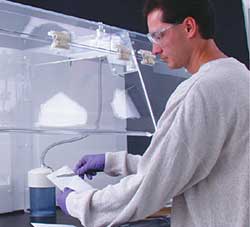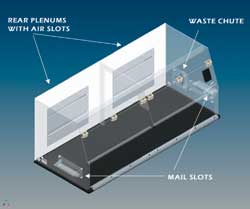Biohazard Control for Mailrooms
Small powders and particulates are readily aerosolized during routine handling procedures. Containment hoods offer increased safety.
THE attack on the World Trade Center and the anthrax scare have forced the government and private industry to increase safety and security precautions. The anthrax scare, in particular, has prompted greater safety controls in the mailroom. Many workplace operations that once were taken for granted have been re-evaluated and new procedures have been implemented. The safety of mailroom operations and the protection of mailroom employees is one such area that has become increasingly critical.
A plethora of free information is readily available on various government Web sites. The FBI, CDC, OSHA, U.S. Postal Service, and General Services Administration have issued recommendations, guidelines, and advisories for the many aspects and conditions of handling mail. This article addresses private mailroom operations (sorting, distributing, and handling) and focuses on the employees actually handling mail and the procedures used.
Biohazard Control
Hazardous agents generally can be divided into three categories: physical (radiological), chemical, and biological. Because mail is routinely X-rayed and also screened for radioactivity, physical hazards will not be addressed. Similarly, chemicals usually are a chronic hazard and do not pose the acute health concerns of biological agents. Therefore, this paper will discuss precautions used for the control of bioagents as defined by NIH/CDC as belonging to biolevel 1, 2, and 3 levels (e.g., anthrax, smallpox, hepatitis, HIV).
The CDC recommends implementing a hierarchical system in mail distribution and handling centers to prevent potential exposure to hazardous biological agents such as anthrax, as shown below:
- Engineering controls to prevent or capture aerosolized spores.
- Administrative controls to limit the number of people potentially exposed.
- Operational (housekeeping) controls to further reduce the spread of spores.
- Personal protective equipment for workers to prevent cutaneous (skin) and inhalation exposure.
These methods should be selected after an initial risk assessment of the work area by a team of experts. The team should include mailroom worker(s), supervisor, industrial hygienist/safety professional, and facilities engineer. The evaluation determines which processes, operations, and tasks are the most likely to produce an exposure if a contaminated envelope or package enters the work area. Most of the administrative, operational, and PPE measures can be implemented immediately after appropriate training by qualified individuals. However, the use of engineering controls can be complicated and requires more time and effort.
It has been shown that small powders and particulates are readily aerosolized during routine handling and transfer procedures such as opening envelopes and packages in mailrooms. Basic industrial hygiene principles state that engineering controls are always the first line of defense when hazardous situations and conditions are encountered. Engineering controls contain the hazard as close to the source as possible when used in conjunction with proper work practices and PPE. This reduces the exposure to potential aerosolized particles and reduces the risk for inhalation, the most severe form of disease exposure. The most difficult part of the problem, however, is identifying suitable engineering controls.
 Figure 1.
Figure 1.
Using Mailroom Containment Hoods
There are four crucial considerations in mailroom containment hoods:
- The hood design
- The filtration system
- The hood location
- The operational work practices.
Hood Design
The design of a hood is like the foundation of a building: The better the foundation, the stronger and more reliable the structure. Figure 1 shows a schematic of a mailroom hood with important parts of the hood labeled. The importance of a validated design that has been thoroughly tested and evaluated cannot be overemphasized. Before purchasing any system, always request the testing and validation data that document the system's containment capabilities.
 Figure 2.
Figure 2.
Good, thought-out hood designs should contain airborne particulate hazards down to at least 0.01 ppm. Because uniform, turbulent-free airflow is crucial for containment, careful attention should be paid to the location and size of exhaust slots and the presence and location of airfoils. Several serious considerations should be addressed. For example, will the air entering the hood be smoothly swept horizontally across the work surface and exhausted through a HEPA-filtered exhaust? Are bag-out HEPA filters used? Are there a plenum and tapers to help move the air smoothly from the hood to the filter and exhaust area? Hoods should be ergonomically designed to provide good visibility of the work area so all operations can be performed efficiently and easily. Are the enclosures available in varying sizes to accommodate various applications? Is the hood surface recessed to contain possible spills? What color is the work surface? Will spilled white powders readily be seen? How easily can the hood be cleaned and decontaminated? Is there sufficient light inside the hood to perform the tasks?
Figure 1 shows one particularly innovative mailroom containment hood. In this instance, mail is placed in a 30-gallon, bag-lined drum that is on a mobile cart. The cart is wheeled under the workstation, and a lift raises the drum through an opening in the base of the hood. The worker is then able to access the mail for opening and sorting according to company protocol from inside the enclosure. A slot on the left side of the hood enables the opened (and now determined safe), processed mail to drop into an outside mail bin. Questionable-looking mail is placed in a biohazard waste bag connected to the hazardous disposal port located beneath the mail slot and secured. The biohazard bag is then sealed and handled by first responder personnel.
Filtration
Hoods used to contain the types of biosafety hazards described in this paper filter the exhaust air through high efficiency particulate air (HEPA) filters. HEPA filters remove a minimum of 99.97 percent of all airborne particulate matter 0.3 micrometers (microns, um) in diameter and larger. Hence, HEPA filters are very effective at removing the type of biohazardous aerosols described in this paper. These filters are an essential part of the hoods used to protect the workers and the environment in mailrooms. The filters can be mounted on the top of the hood or separately.
The mailroom containment hood works by allowing room air to enter the front of the hood through the sash. When designed properly, air moves uniformly across the work surface of the hood and sweeps biohazardous aerosol contaminants though the hood and collects them on the HEPA filter. Eventually the HEPA filters will begin to get loaded with particulates. The rate of loading depends on the rate of airflow and the concentration of particulates in the air exhausted from the hood.
As the filter becomes loaded, the air moving through the hood will eventually slow down because the filter begins to become blocked. Bag-out HEPA filters should be used on mailroom hoods to avoid personnel from coming in contact with any potentially hazardous material on the filters. Only qualified personnel (such as the Safety Office) should change the filters. Spent HEPA filters containing potentially hazardous material are disposed of as hazardous waste by the Safety Office. Filters that are not contaminated may be disposed of in the municipal waste stream.
Several techniques exist to help the hood operator determine when it is time to change the filter. Mailroom hoods are equipped with airflow gauges and alarms that give a direct readout of the airflow in feet per minute (fpm). A range is set when the hood is installed indicating the proper and desired upper and lower airflow limits. If the airflow falls below the bottom limit, an alarm sounds. This can result from the filter becoming loaded or from a mechanical malfunction (power failure, burned-out motor, etc.). If this happens, work stops immediately, the room is secured and posted, and the supervisor and Safety Officer are notified. Under normal operating conditions assuming relatively clean incoming facility room air, HEPA filters can be expected to last for many years.
Another method for monitoring HEPA filters is by installing a gauge across the filter that measures the pressure drop across the filter with a direct readout gauge and alarm. Once again, when the filter becomes loaded the pressure builds and the gauge and alarm indicate it is time to change the filters.
A third alternative is a redundant filter system with two filters mounted in series so if breakthrough does occur, it is contained by the second filter. Good industrial hygiene practices require a ventilation management program whereby the Safety Officer periodically (at least annually, preferably quarterly) inspects the hoods and filters to determine whether the hoods are working according to specifications.
Hood Location
Location and position of the hoods in the mailroom are critical for them to contain the hazard as designed. Cross drafts seriously disrupt the smooth flow of air into the hood and compromise the containment of the hoods. Hoods must be located away from the mainstream of heavy co-worker traffic and away from ceiling supply air vents, fans, windows, and doorways. Access to the hood area should be posted and limited to authorized persons. Similarly, as per OHSA's requirements, eating, drinking, chewing gum, and applying cosmetics is not allowed in the hood area.
To minimize airflow disruptions, all work should be performed in the center of the hood, 6 inches from the sash. Hoods should be kept free from clutter and unnecessary supplies and equipment. If it is necessary to place equipment in the hood, it should be on 2-inch-high square blocks to allow air to flow unhindered around and under the equipment. The presence of pass-through openings is beneficial and favored by employees. Such openings allow waste to be conveniently retained in an out-of-the-way area that is still vented. Hood openings can be used to feed mail, equipment, or supplies into and out of the hoods to avoid overloading.
Operational Work Practices
Only nitrile gloves should be used inside the hood. Latex gloves can cause allergy and sensitivity problems and do not offer sufficient protection. Properly designed and functioning mailroom hoods that are operated correctly protect employees against exposure by containment; therefore, the use of respirators and eye protection is not necessary. When finished working, employees can secure the area, remove their gloves, discard them as non-hazardous waste in the designated area, wash their hands with soap and water, and leave.
Government recommendations are clear on procedures in the event suspicious materials are identified. Employees should leave the enclosure on and not attempt to clean up the hood. Gloves should be removed and left in the hood. The area should be vacated, along with co-workers, and the door closed. Hands should be washed with soap and water and first responders and other designated personnel immediately notified in accordance with a pre-existing emergency response plan. The area should be posted and secured and co-workers' names recorded while awaiting the arrival of the first responder team.
The events of recent years are indeed tragic, but our response to these events has opened the door to improved procedures and innovations to provide a safer and more secure work environment.
This article appears in the March 2004 issue of Occupational Health & Safety.
References
1. CDC, www.bt.cdc.gov/documentsapp/anthrax/10312001/han50.asp
2. FBI, www.jscc.edu/faa/safetyplan/fbi-mail.htm
3. OSHA, www.osha.gov/bioterrorism/pkghandling.html
4. USPS, www.usps.com/news/2001/press/pr01_1022gsa_print.htm
5. GSA, www.gsa.gov/Portal/content/offerings_content.jsp?contentOID=122726&contentType=1004&PMTM=1"
6. CDC, www.cdc.gov/documentsapp/anthrax/10312001/han51.asp
7. Walters, D.B., Why the Weighing Process in Laboratories Must be Enclosed and Vented, 219th American Chemical Society Meeting, Chicago, IL, August 2001.
8. Trammell, R.L., L.H. Keith, D.B. Walters, and A.T. Prokopetz. Packaging and Shipping Test Chemicals for Research. CHEMTECH. 14:97-99 (1984).
9. Trammell, R.L., L.H. Keith, D.B. Walters, and A.T. Prokopetz. Practical Aspects of Packaging and Shipping Test Chemicals for Research. Health and Safety for Toxicity Testing. D.B. Walters, and C.W. Jameson, eds. Butterworth, Boston, MA, 1984.
10. Walters, D. B. The unaimed arrow never misses . . . or properly opening chemical shipments. Chem. Health and Safe. 1998, 5(5),41 and 2002, 9(1),28 (re-issued).
This article originally appeared in the March 2004 issue of Occupational Health & Safety.